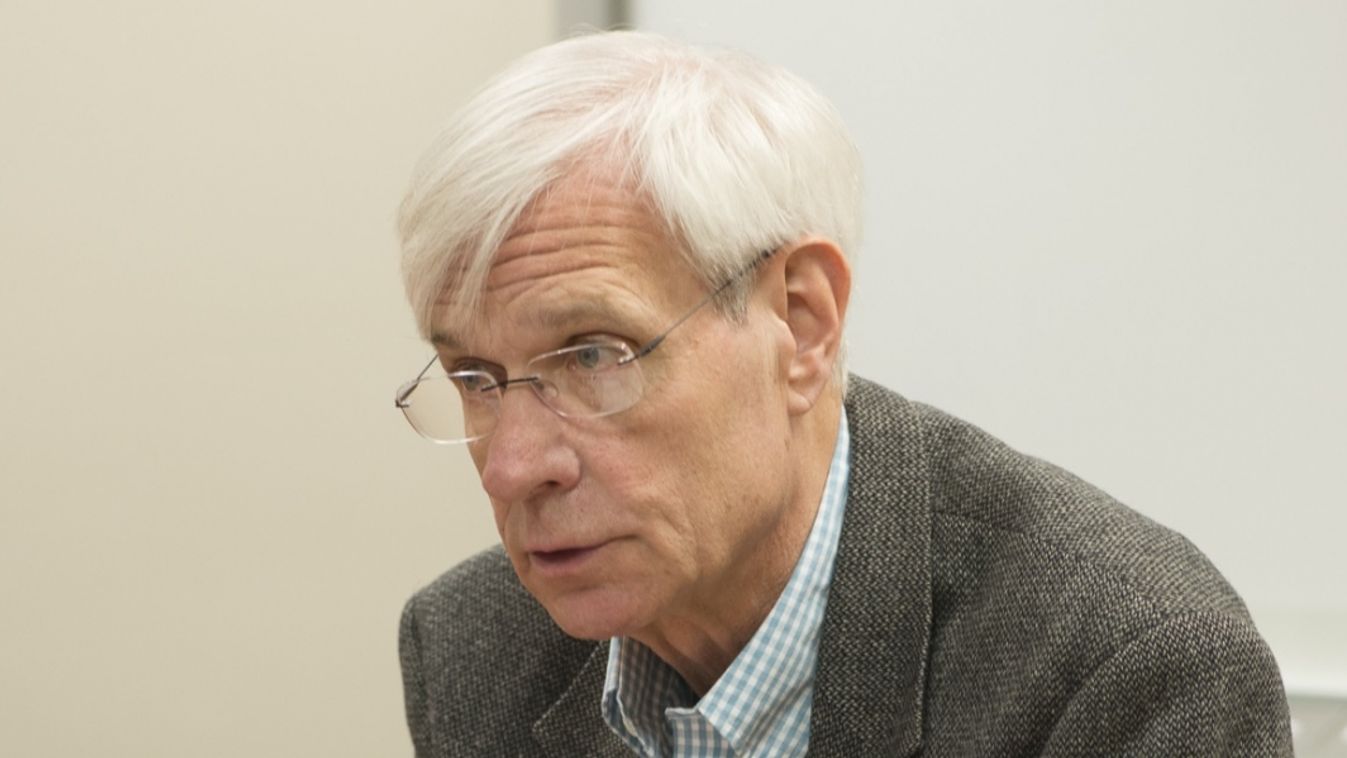Félelem és rettegés lett úrrá Brüsszelen: Orbán Viktor barátja lassan beveszi Bécset

Elképesztő fölényben az Osztrák Szabadságpárt.

The pressure to standardize constitutions around the world is a pernicious assault on national autonomy and individual freedom by unelected elites who think they know what’s best for everyone else. I think it is very important to preserve the Second Amendment, as well as many other American rights that are unpopular with those who hope for an internationalization of constitutional law – says Nelson Lund, Professor of Law at Antonin Scalia School of Law, George Mason University during a conversation with Lénárd Sándor, researcher at the American Studies Research Institute of the National University of Public Service, located in Budapest.

Lénárd Sándor: If one thing is unique to the Bill of Rights of the United States among the various constitutions around the world, then it is the right of the people to keep and bear arms. You are a well-recognized and respected scholar of the Second Amendment. Can you shed some lights on the origins, drafting and historical evolution of this specific right?
Nelson Lund: Partly because of their knowledge of English history and partly because of their own experience with oppression by British troops before our Revolutionary War, America’s founding generation had a strong aversion to the establishment of professional armies during peacetime. Popular sentiment strongly favored the militia system developed in England, in which most able-bodied men were required to undergo part-time, unpaid military training, and to bring their own weapons when called upon to resist sudden threats. When our Constitution was framed and debated, one of the most contentious issues was the allocation of military authority between the state and federal governments. Some believed that it was too dangerous to rely entirely on the state-based militias to deal with invasions, while others believed that professional armies could too easily be used by the new federal government to oppress the people.

L. S.: How did they resolve this debate?
N. L.: Although it was controversial, the Constitution gave the federal government almost plenary authority to establish armies and to regulate the state militias. The Second Amendment did not change this, but it did introduce one completely noncontroversial safeguard. Whatever else the federal government might choose to do with its military authority, the Second Amendment forbade it to interfere with the right of the people to keep and bear arms. This assured the preservation of America’s armed populace, which at that time constituted a meaningful deterrent against federal oppression.
L. S.: From what you’ve said, it does not sound like the Second Amendment had much to do with what we think of as gun control today.
N. L.: That’s right. Originally, the Bill of Rights applied only to the federal government, and the state governments were left completely free to regulate weapons as they saw fit. As it turned out, the federal government never tried to disarm the citizenry, and it did not even regulate firearms until well into the twentieth century. For their part, the states chose to impose very few restrictions during this period. Thus, for more than a century, there was virtually no political demand for gun control, and very little reason to ask whether the Second Amendment put limits on government’s power in this area.
L. S.: From today’s perspective, this is interesting and somewhat surprising. Something must have changed along the way.
N. L.: Yes, there were two especially important developments. During the twentieth century, both the state and federal governments began adopting gun control laws aimed at reducing violent crime. At the same time, the Supreme Court began to apply selected provisions of the Bill of Rights to the state governments. This led to a revival of interest in the Second Amendment, but the lower courts consistently refused to treat the Second Amendment as a check on government power. For many years, the Supreme Court neither endorsed nor repudiated any of these decisions.
L. S.: And when did the Supreme Court finally step in?
N. L.: In 2008, the Justices finally decided to analyze the text and history of the Second Amendment. A majority concluded that a federal law that forbade law-abiding citizens to keep a handgun at home in the nation’s capital was invalid. Two years later, the Court held that the Second Amendment also applies to the states, and invalidated a state law that banned handguns in the city of Chicago. Since that time, the lower courts have upheld most other gun control laws, and we do not yet know whether or to what extent the Supreme Court will find that the right to keep and bear arms extends beyond the right to possess a handgun for protection in your own home.
L. S.: Statistics show that households in America have more than one weapon per person. So the United States is the most armed country in the world and the Second Amendment has clearly become part of the American tradition and culture. Why has this tradition survived into the modern world when so much else has changed?
N. L.: The right to keep and bear arms has indeed been an important part of our culture from the beginning of our history. Later, when the courts became hostile to the right, millions of Americans continued to vigorously insist on what they regarded as their constitutional right to arms. This was a respectable position with deep historical roots. It can be traced back to the English political theorist John Locke, to the English legal theorist William Blackstone, and to our own Declaration of Independence. According to this tradition, the most fundamental human right is the right of self-preservation. That principle implies both the right to resist government tyranny and the right to protect yourself against violent criminals whom the government cannot or will not deter. The framers of the Second Amendment were concerned primarily about a potentially oppressive government, but they understood that securing the right to arms served a broader and more fundamental interest in self-defense. That understanding has survived into the modern world because it is the basis of a comprehensive philosophy of freedom that includes other rights, including the freedom of speech and the free exercise of religion. The Supreme Court has now recognized that the Second Amendment is a legitimate part of the Bill of Rights, which judges are not entitled to treat as a dead letter.
L. S.: Nevertheless, each mass shooting reignites a debate around gun control in the United States. Is there a correlation between states with more stringent gun control regulation and the occurrence of shootings or gun-related death? Can armed citizens prevent crimes?
N. L.: It’s true that proponents of gun control use every mass shooting as an opportunity to push for new restrictions, but they have had little success. The last significant federal law was enacted in 1994, and it was not renewed when it expired ten years later. Mass shootings sometimes lead to new legislation in the few states that already have strict gun control laws, but these new regulations appear to be adopted mostly for their symbolic effect. There is no solid evidence that gun control laws aimed at the general population reduce violent crime. The most stringent laws are generally concentrated in a few states with high crime rates, where they seem to do no good whatsoever. All but a handful of states permit law abiding adults to carry a concealed weapon in public, and armed citizens frequently stop crimes in progress (including mass shootings). Holders of concealed weapon permits almost never misuse their guns. In theory, laws aimed at disarming high-risk individuals (such as those with a history of violent conduct) could have significant effects, but such laws are hard to enforce. Men who don’t obey the laws against murder, rape, and robbery pay no attention to gun control laws. And eliminating the black market in guns is just as infeasible as eliminating the black market in illegal drugs.
L. S.: I would like to ask one more question with regards to the Second Amendment, but from a different perspective. We live in a world where there is a quite large pressure on standardization and unification of constitutional provisions. There are scholars who even say that there is an “internationalization of constitutional law”. Against this backdrop, do you think it is still important to preserve and defend the Second Amendment as well as other rights that are unique to a constitution or part of a constitutional identity?
N. L.: In my opinion, the pressure to standardize constitutions around the world is a pernicious assault on national autonomy and individual freedom by unelected elites who think they know what’s best for everyone else. There are some members of the U.S. Supreme Court who are attracted by this notion, but they have encountered spirited resistance from other Justices. I think it is very important to preserve the Second Amendment, as well as many other American rights that are unpopular with those who hope for an internationalization of constitutional law. Fortunately for us, the United States is less vulnerable than some other nations to the pressures you referred to.
L. S.: Speaking of constitutional values and characteristic constitutional principles, you are also well-recognized for your research in the Separation of Powers. The most important turning points of US history were always about the distribution of powers between the U.S. state governments and the federal government of the United States. Federalism and the autonomy of the States has always been a major building block of American constitutionalism. In your view, has the Supreme Court lived up to this expectation by defending “Federalism” against centralization and what can we expect from the current conservative shift in the Court?
N. L.: Our form of federalism was surely the most important innovation in the U.S. Constitution. The powers that the sovereign people reassigned from the states to the federal government were few and defined. They mostly dealt with national defense and foreign affairs, including foreign trade, as well as with supervising relations among the states. I think you’re right that the most important turning points in our history have involved the allocation of powers between the state and federal governments. For better or worse, powerful centripetal forces have resulted in a steady shift of power to the federal government. Some of those shifts were ratified through formal constitutional amendments, the most important of which were adopted after our Civil War. These amendments abolished slavery and empowered the federal government to stop the former slave states from systematically oppressing the freedmen and their descendants. Other expansions of federal power have not been authorized by constitutional amendments. By the middle of the twentieth century, Congress had usurped much of the states’ reserved authority to protect the health, safety, and morals of their citizens, and Supreme Court doctrine encouraged the indefinite expansion of this reallocation of power. Beginning in the mid-1990’s the Court began trying to impose some limits, but it has accomplished very little. It is possible that the recent conservative shift on the Court will lead to more strenuous efforts in this direction, but I doubt that we will see any significant movement toward the restoration of the original limitations on congressional power. In addition, the Supreme Court itself has usurped power from the states by using bogus interpretations of the Constitution to invalidate state laws on sensitive issues like abortion, same-sex marriage, capital punishment, and the public display of religious symbols. President Trump’s appointments to the Court will probably lead to more restraint, at least for a while. But I doubt that we will see a significant rollback of the intrusions that have already taken place.
L. S.: In addition to issues about the vertical separation of powers between the state and federal governments, there have been some striking changes in the allocation of powers among the branches of the federal government. Can you shed some light on this phenomenon?
N. L.: The changes we’ve seen here are closely related to the erosion of federalism. I think the most important inflection point came during the economic depression of the 1930's, when there was considerable political pressure to use government to strengthen the economy and reduce unemployment. Congress responded with a number of laws that authorized the President to take a great deal of economic decisionmaking away from the free market and repose the decisions in newly created government agencies. In subsequent decades, this became a model for responding to just about anything that was regarded as a national problem. Inevitably, power shifted from Congress to the President and to many agencies over which the President cannot exercise meaningful control. This “headless fourth branch of government,” which resulted from broad legislative delegations of power, now operates with considerable independence from both the President and the Congress. The Supreme Court has acquiesced in this departure from the original constitutional design, and has even facilitated the shift by granting agencies wide discretion to interpret and apply vague and ambiguous statutory grants of power.
L. S.: How do you see the role of the Supreme Court in offering remedies to the most urgent and important constitutional challenges in America?
N. L.: I believe the Supreme Court should simply do its best to honestly apply the original meaning of the Constitution, without injecting the political or policy views of the Justices into the Court’s decisions, and without perpetuating clearly erroneous judicial doctrines from the past. This understanding of the Court’s role is consistent with the ideal of judicial duty developed over many centuries in Great Britain, and it remains very popular with the public. Justice Clarence Thomas has been the only member of the Court to adhere to it, though one of Trump’s appointees - Neil Gorsuch - seems to be adopting a similar approach. On a wide range of politically significant issues, however, a majority of the Court seems likely to continue behaving more like an unelected and unaccountable policymaking tribunal than like a neutral court of law.
***
A cikk a Pallas Athéné Domeus Educationis Alapítvány támogatásával valósult meg.
